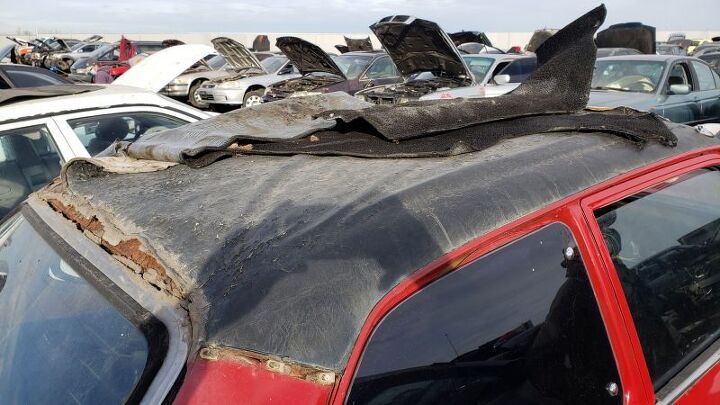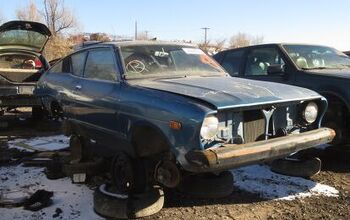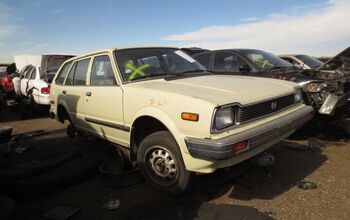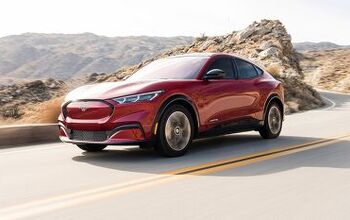Junkyard Find: 1974 Honda Civic Hatchback

The first-generation Honda Civic sold very well in the United States, but it’s just about impossible to find early examples in junkyards these days; I’ve managed to photograph a few ’78s for this series and that’s it. Why? The cars in rust-prone areas dissolved quickly and those in low-corrosion regions got driven to death well before the beginning of our current century. Here’s the oldest discarded 1973-1979 Civic I’ve managed to find since at least the late 2000s.
It got picked over thoroughly by the local Honda fanatics before I got to it, so nearly all of the interior had been ripped out.
While Honda USA offered a “Vinyl Roof Decor” option in 1974, this car appears to have some sort of aftermarket top. Perhaps a dealer installed it, or maybe the car’s original owner brought it to one of the many shops that installed custom vinyl roofs during the middle 1970s.
In any case, the top encouraged some scary body rust over the decades.
The CVCC engine wasn’t available on US-market Civics until 1975, so this is the ordinary 1.2-liter straight-four, rated at 52 horsepower. This car weighed only 1,536 pounds, so 52 horses made it reasonably fun to drive.
The hatchback version cost $2,250, which was a full hundred bucks more than the goofy Civic sedan with its weird little “trunk” opening in back. That comes to $12,700 and $12,135, respectively, in 2021 dollars, making the 1974 Civic one of the best new-car deals of its era and maybe of all time.
Of course, the Civic was a somewhat unknown quantity from a company best-known for motorcycles in the early 1970s; it wasn’t until a few years later that American car shoppers realized that Honda cars were good drivers that held together amazingly well (if you could keep them away from road salt).
The Hubert’s Lemonade bottle as a temporary fuel tank indicates that this car sat for many years before someone made an attempt to get it to move under its own power again. Most likely, that final drive was just down the driveway to a waiting tow truck from U-Pull-&-Pay.
The CVCC stratified-charge system made the Civic even better, though the system got frighteningly complicated by a decade later.
Back in the Civic’s homeland in 1974, the CVCC was the future.
For links to more than 2,100 additional Junkyard Finds, be sure to visit the Junkyard Home of the Murilee Martin Lifestyle Brand™.

Murilee Martin is the pen name of Phil Greden, a writer who has lived in Minnesota, California, Georgia and (now) Colorado. He has toiled at copywriting, technical writing, junkmail writing, fiction writing and now automotive writing. He has owned many terrible vehicles and some good ones. He spends a great deal of time in self-service junkyards. These days, he writes for publications including Autoweek, Autoblog, Hagerty, The Truth About Cars and Capital One.
More by Murilee Martin
Latest Car Reviews
Read moreLatest Product Reviews
Read moreRecent Comments
- GrumpyOldMan All modern road vehicles have tachometers in RPM X 1000. I've often wondered if that is a nanny-state regulation to prevent drivers from confusing it with the speedometer. If so, the Ford retro gauges would appear to be illegal.
- Theflyersfan Matthew...read my mind. Those old Probe digital gauges were the best 80s digital gauges out there! (Maybe the first C4 Corvettes would match it...and then the strange Subaru XT ones - OK, the 80s had some interesting digital clusters!) I understand the "why simulate real gauges instead of installing real ones?" argument and it makes sense. On the other hand, with the total onslaught of driver's aid and information now, these screens make sense as all of that info isn't crammed into a small digital cluster between the speedo and tach. If only automakers found a way to get over the fallen over Monolith stuck on the dash design motif. Ultra low effort there guys. And I would have loved to have seen a retro-Mustang, especially Fox body, have an engine that could rev out to 8,000 rpms! You'd likely be picking out metal fragments from pretty much everywhere all weekend long.
- Analoggrotto What the hell kind of news is this?
- MaintenanceCosts Also reminiscent of the S197 cluster.I'd rather have some original new designs than retro ones, though.
- Fahrvergnugen That is SO lame. Now if they were willing to split the upmarketing price, different story.


















































Comments
Join the conversation
Learned to drive in one of these with an auto.
Had a light blue '75. Ran it dry of oil and Motorwerks (reluctantly) rebuild the engine. Ran it some more. Rear-ended a cherry '70 GTO, twisting the frontend. Ran it some more after headlights replaced running with that twisted frontend. Painted roof in my college colors (no vinyl on mine). Got sick of it and sold it to junkyard. Junkyard covered my roof with a rack and resold it. It was still running into the mid-80s.